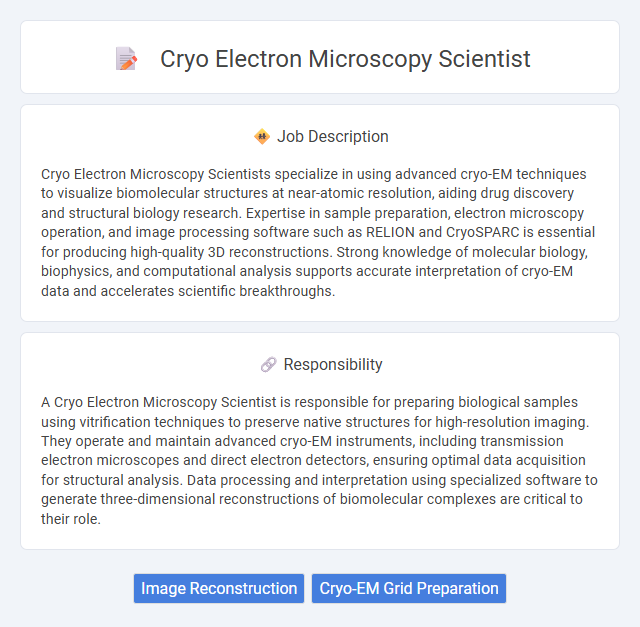
Cryo Electron Microscopy Scientists specialize in using advanced cryo-EM techniques to visualize biomolecular structures at near-atomic resolution, aiding drug discovery and structural biology research. Expertise in sample preparation, electron microscopy operation, and image processing software such as RELION and CryoSPARC is essential for producing high-quality 3D reconstructions. Strong knowledge of molecular biology, biophysics, and computational analysis supports accurate interpretation of cryo-EM data and accelerates scientific breakthroughs.
Individuals with strong analytical skills and a passion for molecular biology might find a Cryo Electron Microscopy Scientist role suitable, as it demands precision and attention to detail during imaging processes. People who prefer collaborative work environments and have patience for repetitive experimental procedures could likely thrive in this position. Those with limited tolerance for long hours in laboratory settings or discomfort with advanced technical equipment may face challenges adapting to this demanding scientific field.
Qualification
A Cryo Electron Microscopy Scientist requires an advanced degree in biochemistry, molecular biology, or a related field, with extensive experience in cryo-EM techniques and sample preparation. Proficiency in operating high-end electron microscopes, image processing software such as RELION or CryoSPARC, and structural biology analysis is essential. Strong skills in data interpretation, automation workflows, and cross-disciplinary collaboration enhance research outcomes in structural determination and molecular mechanism studies.
Responsibility
A Cryo Electron Microscopy Scientist is responsible for preparing biological samples using vitrification techniques to preserve native structures for high-resolution imaging. They operate and maintain advanced cryo-EM instruments, including transmission electron microscopes and direct electron detectors, ensuring optimal data acquisition for structural analysis. Data processing and interpretation using specialized software to generate three-dimensional reconstructions of biomolecular complexes are critical to their role.
Benefit
A Cryo Electron Microscopy Scientist likely experiences significant benefits such as access to cutting-edge imaging technology and the opportunity to contribute to groundbreaking structural biology research. The role probably offers competitive salaries and collaborative environments that enhance professional growth and skill development. Job prospects in this field seem promising due to increasing reliance on high-resolution molecular imaging in pharmaceutical and academic research.
Challenge
Cryo Electron Microscopy Scientist roles likely involve complex challenges in optimizing sample preparation to preserve biological structures at near-atomic resolution, which may require advanced technical skills and innovative problem-solving. The probability of encountering difficulties in data processing and interpretation could be high due to the vast volume of high-resolution images and the need for precise algorithm application. Scientists in this field might frequently face the challenge of balancing experimental accuracy with throughput to meet research deadlines efficiently.
Career Advancement
Cryo Electron Microscopy Scientists experience significant career advancement opportunities through mastery of cutting-edge imaging techniques and data analysis integral to structural biology and drug discovery. Expertise in cryo-EM facilitates progression from research associate roles to lead scientist or project management positions within biotechnology, pharmaceuticals, and academic institutions. Continuous development in cryo-EM methodology and collaborative contributions to high-impact publications enhance professional growth and leadership potential in this specialized field.
Key Terms
Image Reconstruction
Cryo Electron Microscopy (Cryo-EM) Scientists specializing in image reconstruction utilize advanced algorithms and software to transform raw electron micrographs into high-resolution 3D molecular structures. Expertise in Fourier transforms, single-particle analysis, and computational modeling is essential to accurately resolve macromolecular complexes. Proficiency in software tools such as RELION, CryoSPARC, and EMAN2 accelerates the refinement of density maps critical for structural biology and drug discovery.
Cryo-EM Grid Preparation
Cryo Electron Microscopy Scientists specialize in Cryo-EM grid preparation, ensuring optimal sample vitrification with minimal ice contamination for high-resolution imaging. They handle delicate processes such as plunge freezing, blotting, and grid optimization to preserve the native state of biological specimens. Expertise in grid type selection and cryogen handling directly impacts data quality and structural analysis accuracy.
 kuljobs.com
kuljobs.com